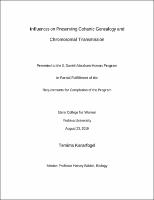Please use this identifier to cite or link to this item:
https://hdl.handle.net/20.500.12202/4761Full metadata record
| DC Field | Value | Language |
|---|---|---|
| dc.contributor.advisor | Babich, Harvey | - |
| dc.contributor.author | Kanarfogel, Temima | - |
| dc.date.accessioned | 2019-10-07T20:47:57Z | - |
| dc.date.available | 2019-10-07T20:47:57Z | - |
| dc.date.issued | 2019-08-23 | - |
| dc.identifier.citation | Kanarfogel, Temima. Influences on Preserving Cohanic Genealogy and Chromosomal Transmission. Presented to the S. Daniel Abraham Honors Program in Partial Fulfillment of the Requirements for Completion of the Program Stern College for Women Yeshiva University August 23, 2019. | en_US |
| dc.identifier.uri | https://hdl.handle.net/20.500.12202/4761 | - |
| dc.description | Senior honors thesis | en_US |
| dc.description.abstract | Abstract: Cohanim are the male patrilineal descendants from the High Priest Aaron (Aharon), brother of Moses (Moshe), who make up the longest spanning dynasty of practicing spiritual and religious leaders in Jewish history. Today, nearly all of those who identify as Cohanim are granted Cohanic status without undergoing any type of verification process. Towards the end of the twentieth century, several scientists took interest in testing the genes of different Jewish populations, including Cohanim, exploring future possibilities of how to verify Cohanim’s claims of their genealogy. Research revealed a signature DNA marker on the Y chromosome, known as a haplotype, that surfaced in more than half of the Cohanim in the study. This haplotype was renamed the Cohen Modal Haplotype (CMH). Unlike Levi’im, the Cohanim’s closely related cousins, and other Jews, Cohanim are unique in having a haplotype that appears in a large percentage of their descendants. This thesis proposes that the persistence of Cohanim’s signature DNA throughout millennia of generations is consistent with three different aspects of the Cohanic legacy. Through analyzing Jewish text, reflecting on Jewish Cohanic history, and discussing the effects of a Jewish Cohanic dynasty, my hypothesis gives three explanations to the CMH phenomenon. The first is the universal recognition of the title “Cohan,” which created an extra barrier between Cohanim and non-Jews that prevented them from intermarrying. The second is the effect that the most recent ruling Cohanic dynasty in Eretz Yisrael had on its posterity as a prominent legacy Cohanim felt obligated to maintain through future generations by reproducing with their own kind. The third is the mutual experience of being stereotyped that consequently bonded Cohanim together, further solidifying their desire to remain insular from outside populations. Collectively, these three reasons can explain the continuity of the CMH. | en_US |
| dc.description.sponsorship | S. Daniel Abraham Honors Program | en_US |
| dc.language.iso | en_US | en_US |
| dc.publisher | NY: Stern College for Women. Yeshiva University. | en_US |
| dc.subject | senior honors thesis | en_US |
| dc.subject | Cohanic genealogy -- Preservation | en_US |
| dc.subject | Chromosomal transmission | en_US |
| dc.title | Influences on Preserving Cohanic Genealogy and Chromosomal Transmission. | en_US |
| dc.type | Thesis | en_US |
| Appears in Collections: | S. Daniel Abraham Honors Student Theses | |
Files in This Item:
| File | Description | Size | Format | |
|---|---|---|---|---|
| Temima Kanarfogel TK_Thesis Aug2019 OptOut.pdf Restricted Access | Student OptOut | 87.24 kB | Adobe PDF |  View/Open |
Items in DSpace are protected by copyright, with all rights reserved, unless otherwise indicated.
